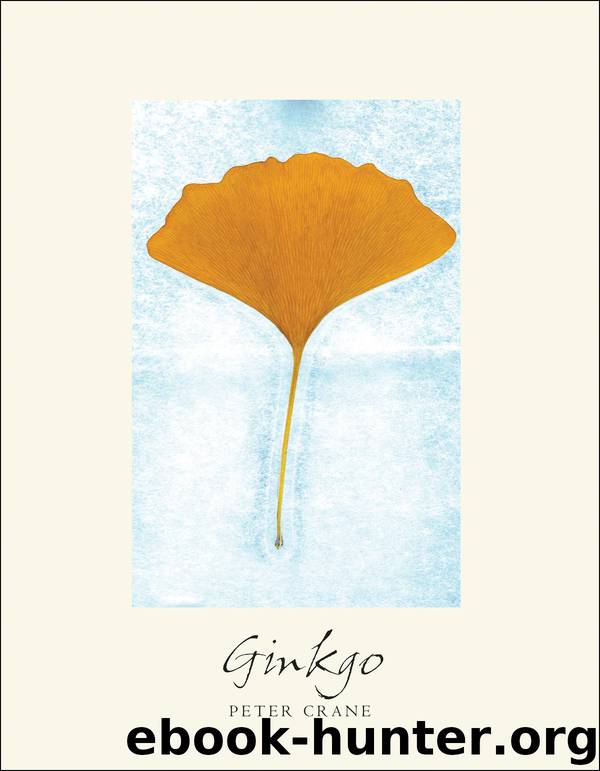Ginkgo by Peter Crane

Author:Peter Crane
Language: eng
Format: epub
Publisher: Yale University Press
Published: 2013-04-08T04:00:00+00:00
PART VI
Use
OVERLEAF, A large ginkgo tree, probably a male, towers over an orchard of smaller female trees in early spring near Sobue, Honshu, Japan.
30
Gardens
The garden suggests that there might be a place where we can meet nature halfway.
—Michael Pollan, Second Nature
Ginkgo owes its resurgence in historical times not just to its utilitarian value but also to some kind of irresistible biological charisma that has taken hold in both Eastern and Western cultures. In the East, ginkgo may have made the transition from wild forests to gardens almost by accident. Buddhist and Taoist priests have long nurtured tracts of forest with ancient trees around their temples. Chinese and Japanese Buddhism in particular believe that achieving nirvana, a state of spiritual liberation, is available to all life, including trees. With their unusual leaves and bizarre chi-chis, ancient ginkgos perhaps embodied an element of Buddha nature. Adopted also by Confucianism and Shintoism, ginkgo became widely revered as a symbol of vitality, longevity, and resilience.1
In the eighteenth century, ginkgo expanded from the forests, temples, and orchards of the East to the botanical gardens and grand estates of the West. Only a few decades after Kaempfer’s first description, living ginkgo, probably as seeds but perhaps as seedlings or cuttings, began to arrive in Europe. Exactly when this took place is uncertain, but that it was no earlier than about 1700 and no later than about 1750 fits the evidence from many different sources. This means that there is no living ginkgo outside China, Japan, and Korea that is more than about three hundred years old.
Given the strong Dutch connections with Japan from the early seventeenth century onward, the earliest introductions of ginkgo into Europe may have been into the Low Countries, and two trees, little more than a hundred miles apart, vie for the title of the oldest living ginkgo outside of Asia. The largest is an old female that stands next to the church in Geetbets, near Hasselt in Belgium. With a trunk now about five feet across, it was reportedly planted around 1730. It is said to have been brought to Belgium by missionaries returning from China. Unfortunately, there is no corroborating evidence, but from its size alone this tree must be an early introduction, certainly from the eighteenth century. Whether it dates from as early as 1730 is less certain, and that age would be unusual for a female tree. Most early ginkgos in Europe are males, probably propagated as cuttings from one or a few original sources; the first record of a ginkgo producing seeds in Europe is not until 1814. A female tree planted in 1730 ought to have been mature in the 1760s or 1770s.2
In competition with the Geetbets tree for the distinction of being the oldest in the West is the large old tree in De Oude Hortus, the old Botanic Garden, close to the center of Utrecht. This tree is a male with a trunk about four feet across, roughly a foot less than the Geetbets tree, but still large.
Download
This site does not store any files on its server. We only index and link to content provided by other sites. Please contact the content providers to delete copyright contents if any and email us, we'll remove relevant links or contents immediately.
Sapiens: A Brief History of Humankind by Yuval Noah Harari(14252)
The Tidewater Tales by John Barth(12608)
Mastermind: How to Think Like Sherlock Holmes by Maria Konnikova(7227)
Do No Harm Stories of Life, Death and Brain Surgery by Henry Marsh(6890)
The Thirst by Nesbo Jo(6826)
Why We Sleep: Unlocking the Power of Sleep and Dreams by Matthew Walker(6618)
Life 3.0: Being Human in the Age of Artificial Intelligence by Tegmark Max(5474)
Sapiens by Yuval Noah Harari(5294)
The Longevity Diet by Valter Longo(5019)
The Body: A Guide for Occupants by Bill Bryson(4974)
The Rules Do Not Apply by Ariel Levy(4861)
The Immortal Life of Henrietta Lacks by Rebecca Skloot(4525)
Animal Frequency by Melissa Alvarez(4395)
Why We Sleep by Matthew Walker(4360)
The Hacking of the American Mind by Robert H. Lustig(4318)
Yoga Anatomy by Kaminoff Leslie(4305)
All Creatures Great and Small by James Herriot(4232)
Double Down (Diary of a Wimpy Kid Book 11) by Jeff Kinney(4207)
Barron's AP Biology by Goldberg M.S. Deborah T(4097)
